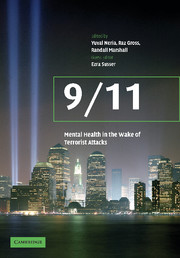Book contents
- Frontmatter
- Contents
- Acknowledgments
- Editors brief bio
- List of contributors
- Foreword
- Part I Introduction
- Part II The psychological aftermath of 9/11
- Part III Reducing the burden: community response and community recovery
- 9 Community and ecological approaches to understanding and alleviating postdisaster distress
- 10 What is collective recovery?
- 11 Rebuilding communities post-disaster in New York
- 12 Journalism and the public during catastrophes
- 13 Effective leadership in extreme crisis
- 14 Guiding community intervention following terrorist attack
- Part IV Outreach and intervention in the wake of terrorist attacks
- Part IV A New York area
- Part IV B Washington, DC
- Part IV C Prolonged-exposure treatment as a core resource for clinicians in the community: dissemination of trauma knowledge post-disaster
- Part V Disasters and mental health: perspectives on response and preparedness
- Index
9 - Community and ecological approaches to understanding and alleviating postdisaster distress
from Part III - Reducing the burden: community response and community recovery
Published online by Cambridge University Press: 27 October 2009
- Frontmatter
- Contents
- Acknowledgments
- Editors brief bio
- List of contributors
- Foreword
- Part I Introduction
- Part II The psychological aftermath of 9/11
- Part III Reducing the burden: community response and community recovery
- 9 Community and ecological approaches to understanding and alleviating postdisaster distress
- 10 What is collective recovery?
- 11 Rebuilding communities post-disaster in New York
- 12 Journalism and the public during catastrophes
- 13 Effective leadership in extreme crisis
- 14 Guiding community intervention following terrorist attack
- Part IV Outreach and intervention in the wake of terrorist attacks
- Part IV A New York area
- Part IV B Washington, DC
- Part IV C Prolonged-exposure treatment as a core resource for clinicians in the community: dissemination of trauma knowledge post-disaster
- Part V Disasters and mental health: perspectives on response and preparedness
- Index
Summary
How do we even begin to understand the aftermath of events as malicious, catastrophic, and far-reaching as the terrorist attacks of September 11, 2001? How can mental health professionals even begin to meet needs that are at once so intense and pervasive? The sections in this chapter illustrate that neither question can be answered without a shift in our thinking that places the community at the crux of the matter. Community is one of those concepts that semantically has meaning for most people but is difficult to define precisely. Not always, but typically, a community is an entity that has geographic boundaries and shared fate. Communities are composed of built, natural, social, and economic environments that influence one another in complex ways. In introducing this section, I will draw upon past research to illustrate the importance of thinking ecologically and systemically with regard to understanding and alleviating the consequences of large-scale disasters.
Understanding the effects of disasters
Event and population dynamics
Understanding the nature and effects of disasters is inherently challenging because it requires attention to event dynamics, population dynamics, community dynamics, social dynamics, and ethno-cultural dynamics. The causes of disasters are many, including natural forces, such as floods, hurricanes, and earthquakes, failures of technology, such as nuclear, industrial, and transportation accidents, and mass violence, such as shooting sprees and peacetime terrorist attacks. Regardless of their cause, disasters damage local infrastructures and strain the ability of local systems to meet the population's basic needs. For the survivors, disasters may engender an array of stressors, including threat to one's own life and physical integrity, exposure to the dead and dying, bereavement, profound loss, social and community disruption, and ongoing hardship.
- Type
- Chapter
- Information
- 9/11: Mental Health in the Wake of Terrorist Attacks , pp. 141 - 156Publisher: Cambridge University PressPrint publication year: 2006
- 4
- Cited by



